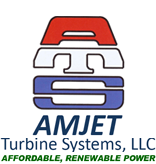Products
DIFFERENCES AMJET vs. CONVENTIONAL
The measurements for defining the size and capacity of all AMJET variable speed
turbines differ from the traditional specification of hydro turbines.
TRADITIONAL SYSTEM
The constant speed requirement relating to the generator matching the grid frequency operates in phase-locked manner. Therefore only one optimal set of performance point specifications (sweet spot) exist with all other lower performance parameters taken as a function of this optimal performance point. To match all other operating conditions, flow direction-altering mechanical controls namely runner pitch control and stator pitch (wicket gate) control are used, driven by a governor, that lowers turbine efficiency. The governor also sets rotational speed for synchronization.
AMJET VARIABLE SPEED SYSTEM
The variable speed system relies on a fixed optmimal hydrodynamic design that operates at high efficiency at any runner speed. The electronic torque control, part of the DC rectifier, controls the rotational speed to obtain maximum efficiency at any head (max. current at max. voltage). Therefore the performance curve uses head (horizontal axis) as the master variable and output, flow, rotary speed, torque and efficiency as the dependent variables (vertical axis). See chart below of the ATS-63 with head horizontal and Power (kW), Flow (cfs) and Efficiency (%) on the vertical scale

Fig. 6 ATS-63 Performance Curves
ATS AMJET TURBINE/GENERATOR MODELS
ATS has under development three basic units to benefit 3 major market segments.
AMJET ATS-8 (click here for PDF)
-
• Internal diamter 8" (see Fig.7)
• Output 3kW-50kW 480/680V 3PH 50/60hz
• Head 7’ (2.2m) to 50’ (15.2m)
• Flow 6.5cfs (0.18m3/s) to 15cfs (0.45m3/s)
-
• Micro Hydro to 100ft (30m) 2 in series
• Municipal waterworks energy recover
• Head 7’ (2.2m) to 50’ (15.2m)
• Head 7’ (2.2m) to 50’ (15.2m)
• Micro Hydro to 100ft (30m) 2 in series
• Municipal waterworks energy recovery
• Military and industrial temporary power
A proto-type was built and laboratory tested to confirm the operating principles and as a 1/8 scale model for the ATS-63 (below). This unit is being placed on a dam to confirm laboratory numbers and establish ORNL government standards for variable speed turbines. A second 3D printed ATS-8 is built and will be installed.
AMJET ATS-32 (click here for PDF)
-
• Internal diameter 32” (see Fig.8)
• Output 50kW-850kW 480/680V 3PH 50/60hz
• Head of 7’ (2.2m) to 50’ (15.2m)
• Flow of 98 (2.8cms) to 250cfs (7cms). Applications:
• Conduit Hydro installations
• Small to medium River Dams multiple units
• New Stream Reach installations
• Standard Modular Hydro installations
AMJET ATS-63 (click here for PDF)
- • Internal diameter 63” (see Fig.9)
• Output 200-2500kW 480/680V 3PH 50/60hz
• Head of 7’ (2.2m) to 50’ (15.2m)
• Flow of 395cfs (11.2m3/s) to 925cfs (26.2m3/s)
. Applications:
• Conduit Hydro installations
• Medium to large River Dams multiple units
• New Stream Reach installations
• Standard Modular Hydro installations
Test installation was done on Brainerd MN dam in the Mississippi. Unit will be re-installed when all test results have been reviewed and implemented.

Fig. 7 ATS-8 on test stand

Fig. 8 ATS-32 rendering, all composite components

Fig. 9 ATS-63 all-composite turbine/generator
installed in Mississippi dam, Brainerd, MN
